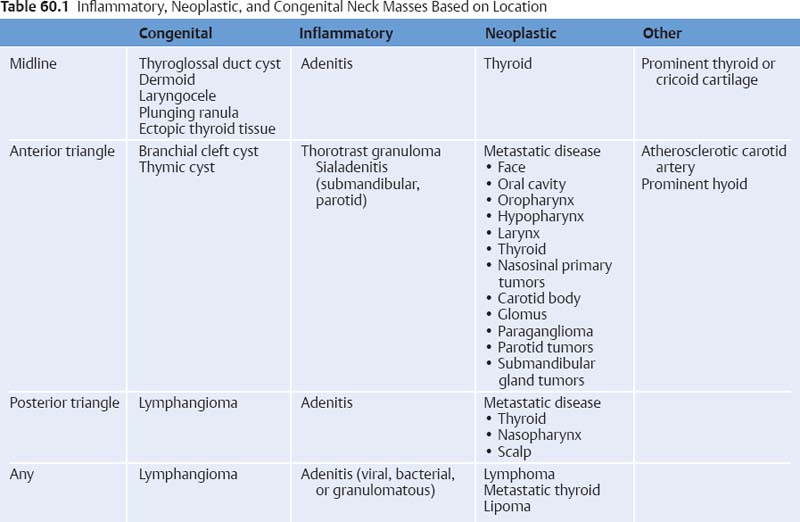60 Neck Mass The two most important features regarding the evaluation of a neck mass are the age of the patient and the location in the neck. In general, the differential diagnosis of a neck mass can be broken into three main categories—inflam matory, neoplastic, and congenital. For patients under the age of 15, inflammatory etiologies make up the majority of neck masses followed by congenital and neo-plastic pathology. Into young adulthood, the frequency of etiologies in these categories remains similar to the pediatric population. As the patient approaches the age of 40, however, the concern for neoplastic etiologies becomes paramount. This is followed by inflammatory and, finally, congenital causes. After the age of the patient is considered, location of the neck mass serves greatly to narrow the differential diagnosis. Table 60.1 presents a breakdown of the various inflammatory, neoplastic, and congenital neck masses based on location. This chapter focuses exclusively on presenting symptoms and signs found on the patient’s history and physical exam. Used in conjunction with an appreciation of the age and location in which neck masses present, the history and physical can aid the clinician greatly in narrowing the differential diagnosis and deciding on the next step in evaluation or treatment. Possible etiologies are described according to characteristics and associated symptoms. Cervical lymph nodes that are under 1 cm are most often the result of a benign, inflammatory process. Lymph nodes greater than 1.5 cm generally require additional evaluation, particularly in the patient with risk factors for malignancy or systemic symptoms. Benign lymph nodes are mobile and not fixed to adjacent structures. Nodes that are immobile are more concerning for a malignant etiology. Assessing mobility is of great importance to the head and neck surgeon, both in determining the risk for cancer and in surgical planning. Masses that are fixed generally indicate more advanced disease and, at times, can even mean unresectability of a mass. A pathognomonic sign for a thyroglossal duct cyst on physical exam is vertical motion of a midline mass with swallowing or tongue protrusion. Carotid and vagal paragangliomas are mobile side-to-side, but they are immobile in the craniocaudal direction.
 Characteristics
Characteristics
Size
Mobility
Consistency
Soft
 Benign lymph nodes are soft and fleshy on exam. Cervical lymph nodes that are firm and matted are more concerning for a malignant etiology.
Benign lymph nodes are soft and fleshy on exam. Cervical lymph nodes that are firm and matted are more concerning for a malignant etiology.
 Lymphomas are discrete, rubbery, and nontender. Systemic symptoms should be investigated in young adults with a neck mass concerning for lymphoma.
Lymphomas are discrete, rubbery, and nontender. Systemic symptoms should be investigated in young adults with a neck mass concerning for lymphoma.
 Lymphangiomas are characteristically soft, doughy, and compressible with indistinct margins. These congenital masses can also be diagnosed by characteristic transillumination and should be evaluated with computed tomography (CT) or magnetic resonance imaging (MRI) to delineate the extent of disease.
Lymphangiomas are characteristically soft, doughy, and compressible with indistinct margins. These congenital masses can also be diagnosed by characteristic transillumination and should be evaluated with computed tomography (CT) or magnetic resonance imaging (MRI) to delineate the extent of disease.
 Hemangiomas are also soft and compressible but can be distinguished from lymphangiomas by their red or bluish color. They increase in size with straining, and sometimes a bruit may be auscultated. Again, imaging is valuable to appreciate the extent of disease.
Hemangiomas are also soft and compressible but can be distinguished from lymphangiomas by their red or bluish color. They increase in size with straining, and sometimes a bruit may be auscultated. Again, imaging is valuable to appreciate the extent of disease.
 Lipomas are soft, ill-defined, subcutaneous masses that generally present in patients over the age of 35. Although CT imaging is helpful in the evaluation of this mass, the characteristic consistency of this lesion is often sufficient for diagnosis.
Lipomas are soft, ill-defined, subcutaneous masses that generally present in patients over the age of 35. Although CT imaging is helpful in the evaluation of this mass, the characteristic consistency of this lesion is often sufficient for diagnosis.
 Thyroglossal duct cysts, branchial cleft cysts, and thymic cysts are all congenital lesions that, in their chronic state, are soft and doughy. However, they often present acutely in the setting of a recent infection as a firm, swollen, and tender mass.
Thyroglossal duct cysts, branchial cleft cysts, and thymic cysts are all congenital lesions that, in their chronic state, are soft and doughy. However, they often present acutely in the setting of a recent infection as a firm, swollen, and tender mass.
 Ectopic thyroid tissue can be found anywhere from the base of the tongue to the thyroid cartilage and is soft to palpation.
Ectopic thyroid tissue can be found anywhere from the base of the tongue to the thyroid cartilage and is soft to palpation.
Firm
 Lymph nodes that are firm, fixed, and/or matted are more concerning for a malignant or atypical inflammatory condition and require further work-up. Fluctuance and induration are indications of infectious etiology such as suppurative bacterial lymphadenopathy.
Lymph nodes that are firm, fixed, and/or matted are more concerning for a malignant or atypical inflammatory condition and require further work-up. Fluctuance and induration are indications of infectious etiology such as suppurative bacterial lymphadenopathy.
 Teratomas are firm masses that are generally present at birth or in the first year of life. Heterogeneity and calcifications are generally appreciated on CT and MRI.
Teratomas are firm masses that are generally present at birth or in the first year of life. Heterogeneity and calcifications are generally appreciated on CT and MRI.
 Hematomas in the anterior neck following trauma (forceps delivery in newborns) are generally firm and in the area of the sternocleidomastoid muscle.
Hematomas in the anterior neck following trauma (forceps delivery in newborns) are generally firm and in the area of the sternocleidomastoid muscle.
Stay updated, free articles. Join our Telegram channel

Full access? Get Clinical Tree



